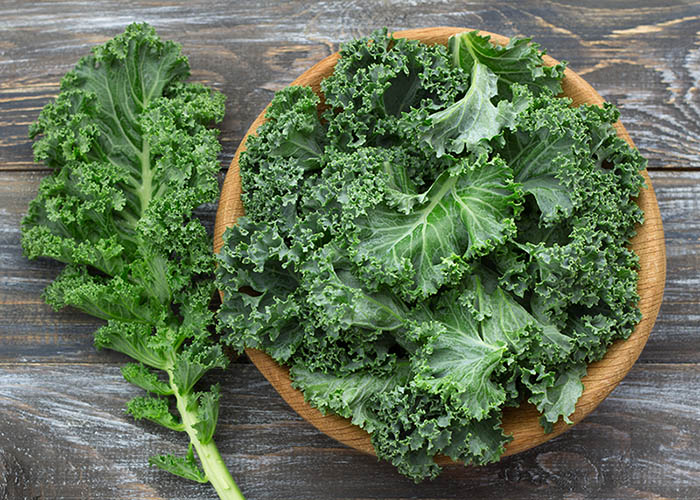
Everyday Chemicals Are Screwing Up Your Testosterone
You may have already read my other article on 7 habits which are killing your testosterone. There was a section in that on Water because

Kale boosts whole-body vitality, from stronger bones and heart health to the digestive system. It’s been gaining loads of attention as one of the ‘superfoods’ we all should include in our diets.
Kale was a part of the ancient Roman diet and a popular vegetable during the Middle Ages when precious land couldn’t be wasted growing nutrient-poor crops.
It’s in the same family as Brussels sprouts, Bok-Choy, and cabbage. All of which are cruciferous vegetables rich in glucosinolates; a sulfur-based substance with remarkable health benefits (1).
When you eat vegetables like kale, the glucosinolates in them are broken down by digestion into certain metabolites; substances that affect metabolism and trigger specific enzymatic reactions (2).
Glucosinolates break down into metabolites that have an affect similar to antibiotics and can ward off bacterial, fungal, and even viral infections in all parts of the body (3,4).
Two recent studies also suggest that cruciferous vegetable rich diet could reduce the risk of some cancers (5).
One analysis coordinated by the National Cancer Institute (NCI) reviewed 31 epidemiological studies to see if there was an association between intake of cruciferous vegetables and risk of lung cancer concluded that eating glucosinolates rich vegetables could decrease risk by 17 to 23 percent (6).
Another study by the Italian Department of Epidemiology at the Institute of Pharmacological Research reported that regular intake of cruciferous vegetables could reduce the risk of colorectal, esophageal, kidney, and breast cancer by almost 25 percent (7).
However, eating a diet rich in cruciferous plants doesn’t mean that you’re actually getting most benefit from glucosinolates.
This is because cooking vegetables can destroy an enzyme called myrosinase. This enzyme is what helps convert glucosinolate into health-promoting metabolites (8).
Although cooking won’t entirely remove these benefits, it will considerably degrade them.
Ideally you want to get your kale raw to enjoy the biggest health boost.
For starters just one cup of kale gives you over 100 percent of your daily recommended amount of vitamin A and almost 150 percent of vitamin K for calcium metabolism and bone health (9,10).
You’ll also get two grams of protein and one gram of fiber with only about 33 calories.
A recent study finds that patients with high cholesterol who drank kale juice reduced their levels of LDL cholesterol by 10 percent (11).
Researchers think is because of the way kale binds to the bile acids secreted by the liver.
This binding prevents those acids from being reabsorbed so they pass out of the body instead. The body will instead rely on its stored cholesterol to replace that bile acid, reducing cholesterol levels.
Kale and other dark leafy veggies naturally contain thylakoids. A substance discovered in the early 90s that could be used as an appetite suppressant.
Studies show that foods rich in thylakoids effectively reduced insulin levels (12). Spikes in insulin can cause blood sugar to drop, triggering hunger pangs.
Research also found that thylakoids reduce levels of ghrelin, the hormone that stimulates hunger, while increasing levels of leptin, a hormone that signals the brain that you’re full.
Besides being essential for bone health, vitamin K has a strong ant-inflammatory affect in the body (13) – which can help relieve symptoms of joint pain and helps maintain circulatory health.
Even better, kale has both omega-3 fatty acids and the antioxidant sulforaphane that also act to significantly reduce inflammation (14,15).
Vitamin C is a water-soluble antioxidant vitamin crucial for health that serves many critical functions in our cells.
It’s needed to create and maintain collagen, an abundant structural protein in your skin and joints.
Much higher in this vitamin than many other vegetables, kale contains roughly 4.5 times much as the same amount of spinach (16).
As one of the best sources of vitamin C, a cup of raw kale has more vitamin C than an entire orange (17).
Kale is high in the minerals that many people are deficient in.
It’s a fantastic source of calcium; a mineral extremely important for bone health that also plays a role in many health-critical cellular processes.
Kale is also a good source of magnesium. Most people don’t get enough of this incredibly important mineral.
Getting sufficient dietary magnesium can even be protective against heart disease and type 2 diabetes (18).
Kale contains potassium, the mineral that works to maintain proper cell function and an essential electrolyte.
Healthy potassium intake has been linked to lowered blood pressure and a reduced risk of cardiovascular disease (19).
A big advantage kale has over other leafy greens, like spinach, is that it is low in oxalate, a substance some plants have that can block essential minerals from being absorbed in the body (20).
I know how difficult it can be to eat kale every single day and that is why we included 500 mg at 5:1 concentrate (equivalent to 2,500 mg) in our Next Level Superfoods Multivitamin!

You may have already read my other article on 7 habits which are killing your testosterone. There was a section in that on Water because

Rhodiola Rosea stands out as a potent adaptogenic herb with a rich history of traditional use and a growing body of scientific research. Revered for

In this comprehensive article, we will explore what L-tyrosine is, its benefits as a pre-workout supplement, the correct dosage, and other potential health benefits it

Betaine anhydrous is becoming an increasingly popular ingredient for pre-workouts. In this article, we will explore the fundamentals of betaine anhydrous, its connection to carnosine,

Beta-alanine is a pre-workout powerhouse. From boosting workout performance to potential anti-aging effects, discover why this amino acid is a favorite among health buffs.

You may have already read my other article on 7 habits which are killing your testosterone. There was a section in that on Water because

Rhodiola Rosea stands out as a potent adaptogenic herb with a rich history of traditional use and a growing body of scientific research. Revered for

In this comprehensive article, we will explore what L-tyrosine is, its benefits as a pre-workout supplement, the correct dosage, and other potential health benefits it
Discount Applied Successfully!
Your savings have been added to the cart.